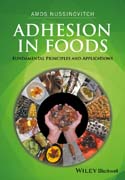
To the layman, adhesion is a simple matter of how well two different materials stick together, and adhesion measurements provide some indication of the force required to separate them. However, a more detailed look at adhesion shows that it is a very important feature of food throughout its manufacturing, packaging and storage. Chapters are fully devoted to the fascinating topic of adhesion in foods. Key features of the book include, but are not limited to: definition and nomenclature of adhesion; adhesion mechanisms and measurements; stickiness in various foods and its relation to technological processes; perception of stickiness; hydrocolloids as adhesive agents for foods; adhesion phenomena in coated, battered, breaded and fried foods; electrostatic adhesion in foods; multilayered adhered food products, and adhesion of substances to packaging and cookware. Adhesion in Foods: Fundamental Principles and Applications is dedicated not only to the academic community but also to the broader population of industrialists and experimentalists who will find it to be not only a source of knowledge, but also a launching pad for novel ideas and inventions. In particular, this book is expected to be of interest to personnel involved in food formulation, food scientists, food technologists, industrial chemists and engineers, and those working in product development. INDICE: About the author .Preface .Acknowledgments .Outline Adhesion .1 Adhesion: definition and nomenclature .1.1 Introduction .1.2 A brief history of adhesives .1.3 Nomenclature and definitions of adhesion terms .1.3.1 Adhere .1.3.2 Adherend .1.3.3 Adhesion .1.3.4 Adhesion ability in insects and the gecko .1.3.5 Adhesive .1.3.6 Adhesive assembly .1.3.7 Adhesive bonding .1.3.8 Bacterial adhesion .1.3.9 Cell–adhesion molecules .1.3.10 Contact adhesive .1.3.11 Contact mechanics .1.3.12 Lateral adhesion .1.3.13 Mechanisms of adhesion .1.3.14 Mucoadhesion .1.3.15 Pressure–sensitive adhesives (PSAs) .1.3.16 Strength of adhesion .1.3.17 Wettability .1.4 Concluding remarks .References .2 Adhesion mechanisms and measurements .2.1 Introduction .2.2 The phenomenon of adhesion .2.2.1 Mechanical interlocking .2.2.2 Electrical model .2.2.3 Diffusion model .2.2.4 Thermodynamic adsorption .2.2.5 Rheological model .2.2.6 Chemical bonding theory .2.2.7 Food model adhesion: conclusions .2.3 Methods of determining adhesion of food materials .2.3.1 Introduction .2.3.2 Adhesion evaluations .2.3.2.1 Weighing .2.3.2.2 UV absorbance measurements .2.4 Adhesion strength measurements .2.5 Wettability .2.5.1 Introduction .2.5.2 Tilted plane .2.5.3 Contact angle .2.5.4 Liquid surface tension .References .3 Stickiness of foods and its relation to technological processes .3.1 Introduction .3.2 Dough properties and stickiness .3.3 Cookies, breads, cakes and pasta .3.3.1 Cookie composition and stickiness .3.3.2 Bread ingredients and stickiness .3.3.3 Cakes .3.3.4 Influence of ingredients on pasta stickiness .3.3.5 Stickiness of miscellaneous products .3.4 Stickiness of rice .3.5 Fruit powders .3.6 Stickiness of milk powders .3.7 Cereal products .3.8 Relations between technological processes and stickiness .3.8.1 Spray–drying of sugar–rich foods .3.8.2 Foam–mat drying .3.8.3 Extrusion and cooking in a microwave oven .References .4. Perception of stickiness .4.1 Introduction .4.2 Collection and classification of words for descriptions of food texture .4.3 Principles of objective measurements of stickiness .4.4 The problematic nature of instrumental determinations .4.5 Perception of stickiness in oil–in–water dairy emulsions .4.6 Stickiness of dispersions, semi–solids and sugar–rich foods .4.6.1 Perception of particles in food .4.6.2 Stickiness of fluid foods .4.6.3 Perception of sugar–rich foods .4.7 Changes in sensory stickiness perception with age .References .5. Hydrocolloids as adhesive agents in foods .5.1 Introduction .5.2 Food uses and applications of adhesives .5.3 Hydrogel adherend relationships and structure function issues .5.4 Hydrocolloid adhesion tests .5.5 Hydrocolloids as wet glues .5.6 Hydrocolloids as adhesives in foods .5.6.1 Fried food products .5.6.2 Adhesion of seasonings .5.6.3 Jams .5.6.4 Food coatings .5.6.5 Miscellaneous applications .5.7 Hydrocolloid adhesion: future prospects and possible developments .References .6. Adhesion phenomena in coated, battered, breaded and fried foods .6.1 Introduction .6.2 A few definitions .6.2.1 Instead of an overview .6.2.2 Breading materials .6.2.3 Batters .6.2.4 Pre–dust or pre–dip systems .6.3 Enrobing processes .6.4 Types of batter and their use in different products .6.4.1 Batters containing different types of protein .6.4.2 Cake batters .6.4.3 Batter–coated fried products .6.4.4 Fried battered nuggets .6.5 Breaded products .6.5.1 Breaded fish portions .6.5.2 Breaded chicken drumsticks, breasts and other parts .6.6 New batters and breadings .References .7. Electrostatic adhesion in foods .7.1 Introduction .7.2 Technology of electrostatic powder spraying .7.3 Adhesion of food powders to food products .7.4 Adhesion of sodium chloride and its effect on coating .7.4.1 Potato chips .7.4.2 Baked goods and vegetables .7.5 Other food–related uses of electrostatic adhesion .7.5.1 Edible coatings .7.5.2 Membranes .7.5.3 Casein interactions .7.5.4 Adhesion of microbes and viruses .7.5.5 Self–assembled hydrophobin bilayers .7.5.6 Adhesion and spread of emulsion droplets on solid surfaces .References .8. Multilayered Adhered Food Products .8.1 Introduction .8.2 Multilayered hydrocolloid–based foodstuffs .8.3 Stiffness and compressive deformabilities of multilayered texturized fruits and gels .8.4 Other edible multilayered hydrocolloid products .8.5 Layered cellular solids .8.6 Future biotechnological potential uses of multilayered gels .8.7 Methods to estimate properties of multilayered products .8.8 Current systems and methods to prepare multilayered products .8.9 Problems related to multilayered and colored products .References .9. Adhesion of substances to food packaging and cookware .9.1 Wetting properties of food packaging .9.2 Adhesion of fermented dairy products to packaging materials .9.3 Active food packaging and bacterial adhesion .9.4 Antimicrobial food packaging .9.5 Protein adsorption to processing surfaces .9.6 Adhesion of edible oils to food–contact surfaces .9.7 Microorganism adhesion to and oil removal from modified surfaces .9.8 Aspects of non–stick coatings for cookware .References .Index
- ISBN: 978-1-118-85161-6
- Editorial: Wiley–Blackwell
- Encuadernacion: Cartoné
- Páginas: 224
- Fecha Publicación: 27/01/2017
- Nº Volúmenes: 1
- Idioma: Inglés
